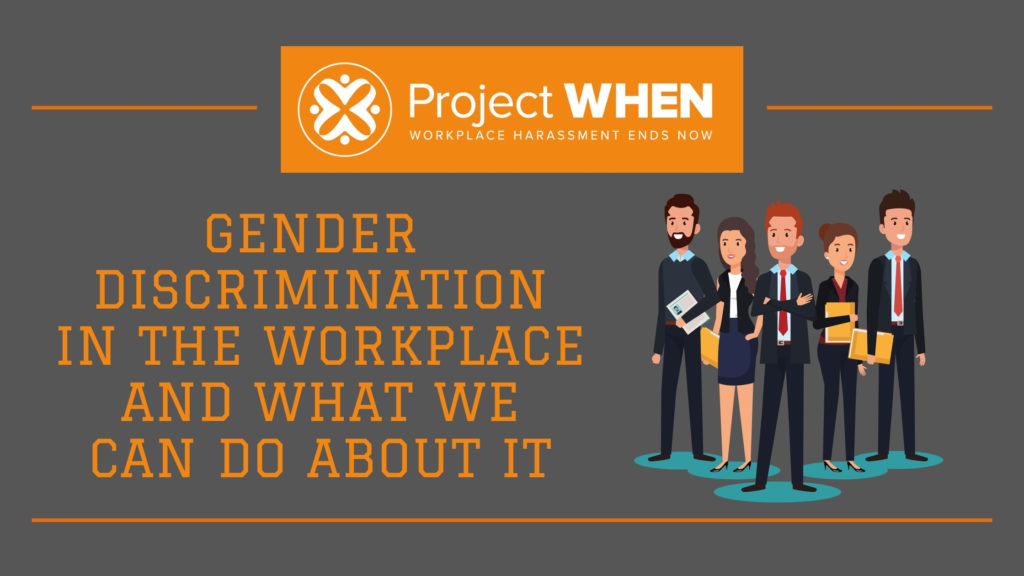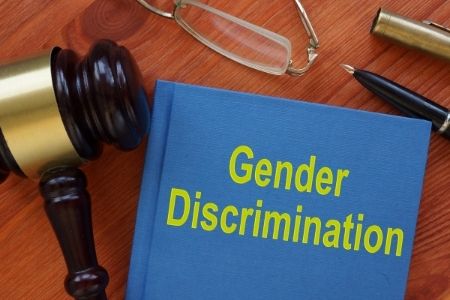Gender discrimination: How companies can prevent it and what employees can do if it happens

Awareness against gender discrimination
 Are you a victim of sex or gender discrimination at your place of employment? Perhaps you have observed it happening in your workplace? Let’s explore some key facts that can help you put an end to this injustice.
Are you a victim of sex or gender discrimination at your place of employment? Perhaps you have observed it happening in your workplace? Let’s explore some key facts that can help you put an end to this injustice.
Our mission at Project WHEN (Workplace Harassment Ends Now) is to elevate awareness to eliminate harassment and create more respectful workplaces. This post on gender discrimination is part of our series of pages educating the public about various types of workplace harassment, how employers can prevent it, and employees’ rights under the law.
What is sex or gender discrimination in the workplace?
Gender discrimination (often called sex discrimination in legal settings) occurs when an applicant or employee is treated unfairly because of the person’s sex. According to the U.S. Equal Employment Opportunity Commission (EEOC), sexual orientation and gender identity (e.g. transgender status) can also be the basis of sex discrimination.
Sex discrimination versus sexual harassment
Since sexual harassment is a form of sex discrimination under the law, there may be a fine line between the former and the latter, but these two terms have key distinctions. Knowing these differences is essential for any employer looking to avoid the occurrence of this problem or for individuals (employees or applicants) who want to know how to deal with it.
Sex discrimination happens when an individual receives less favorable treatment for being male or female. For example, an employer with a pattern of laying off only female employees is discriminating against those individuals due to their gender.
Sexual harassment, on the other hand, involves a variety of acts that are of sexual nature or offensive behavior that creates a hostile working environment to a person of a specific gender. Sexual harassment can generally take two forms:
1) any unwelcome conduct of sexual nature such as sexual advances; inappropriate requests for sexual favors; unwanted verbal or physical abuse; and quid pro quo, the act of offering employment benefits or conditions in exchange for sexual acts; and/or
2) conduct that is not of sexual nature but causes the victim to suffer hostile working conditions such as repeatedly subjecting an individual to gendered insults or gender-related slurs. Frequently calling a female employee a “slut” or a “bitch” is an example of this conduct.
In this post, we’ll touch on real examples of gender discrimination in the workplace, the laws offering protection from it, and the recourse victims have under the law. Importantly, we’ll also cover what employers can do to prevent it from occurring in the workplace, along with delving into what companies should do to address gender discrimination claims. You’ll also find a number of resources we believe are helpful for those dealing with this problem.
Examples of gender discrimination
 Employment decisions that negatively impact people of a certain sex or gender is a manifestation of gender discrimination. An employee may start to be paid less, passed over for promotions, ignored in important meetings, or overlooked for important assignments. Job candidates may also be rejected for no other reason than their gender.
Employment decisions that negatively impact people of a certain sex or gender is a manifestation of gender discrimination. An employee may start to be paid less, passed over for promotions, ignored in important meetings, or overlooked for important assignments. Job candidates may also be rejected for no other reason than their gender.
One example is shown in a lawsuit against a leading national food distributor that practiced a systematic refusal to hire female job applicants. The pattern of denying women operative positions at the company’s Broadline facilities had been going on since 2004. In addition to this conduct, it was also revealed that the company refused to promote a female employee due to her sex, even if she was qualified.
To settle the lawsuit, the company will provide monetary relief to the victims who suffered sex discrimination in employment. The female applicants will receive $5,000,000 while $75,000 will be paid to the female employee that the employer failed to promote.
Transgender individuals are also protected under the law. Another case involved a transgender employee who was dismissed from her position as a funeral director. The decision to fire her came after the employee told her employers that she will be undergoing a transition from male to female.
The court concluded that firing the employee based on her transgender status is a violation of Title VII of the Civil Rights Act that prohibits discrimination based on sex. To resolve the lawsuit, the transgender employee will receive $130,000 in back pay and compensatory damages. The company will also pay the victim’s attorney fees amounting to $120,000.
These examples are based on real gender discrimination lawsuits filed by the EEOC, a federal agency responsible for enforcing employment discrimination laws.
Statistics on gender discrimination
According to data visualizations of charges received by the EEOC, sex-based discrimination is one of the most reported basis of discrimination. In fiscal year 2019, the federal agency recorded 23,532 charge receipts while monetary benefits received by aggrieved individuals soared to a whopping $170.7M. This is a 32% increase since 2010.
It is evident that gender discrimination in the workplace is still a rampant and pervasive issue that needs to be addressed. Employers may think that their actions do not have serious consequences and victims may not have a clear understanding of protections available to them. Awareness is of utmost importance, first and foremost, in these situations. Read on to explore what laws protect you from it, as well as key actions to take by both companies and victims in dealing with this type of discrimination.
Gender discrimination laws
Federal law
The EEOC enforces several laws that make it unlawful for employers to discriminate against an individual because of sex or gender.
Title VII of the Civil Rights Act of 1964
 This federal law prohibits employment discrimination on the basis of a person’s sex, as well as race, color, religion, and national origin. Under Title VII, it is unlawful to take employment actions (such as hiring, firing, compensation, training, job assignments, promotions, layoff and benefits) based on one’s sex and stereotypical assumptions about a certain gender’s characteristics and abilities.
This federal law prohibits employment discrimination on the basis of a person’s sex, as well as race, color, religion, and national origin. Under Title VII, it is unlawful to take employment actions (such as hiring, firing, compensation, training, job assignments, promotions, layoff and benefits) based on one’s sex and stereotypical assumptions about a certain gender’s characteristics and abilities.
Although discrimination is often experienced by women, the law’s protection also applies to men. Furthermore, as enforced by the EEOC and as ruled in certain court decisions, discriminating individuals because of their gender identity or sexual orientation is also a form of discrimination based on sex under Title VII.
Harassing someone because of that person’s sex is also illegal under the law. It is important to note, however, that one-off teasing and isolated incidents (unless extremely serious) may not be considered illegal. The offensive behavior must create a threatening and hostile work environment or result in adverse employment action to be unlawful.
The harasser does not have to be of opposite sex for sexual harassment to happen; it can occur between individuals of the same sex. The victim’s harasser can also be a supervisor, manager, leader, employer’s agent, co-worker and even those external to the company such as vendors and customers.
When it comes to employment practices, a seemingly neutral policy or practice that negatively affects employees of a particular sex may be considered unlawful, especially if it is not essential for business operations.
Another main provision this law offers is protection against retaliation. An employer may not punish or retaliate against an individual who is actively asserting his/her rights. Protected activities include filing a discrimination charge, using complaint processes to oppose discriminatory practices, and participating in legal proceedings or investigations alleging workplace harassment.
Title VII applies to business/private employers with 15 or more employees, employment agencies, state or local governments, federal government agencies, and labor organizations or joint apprenticeship committees.
Below is an excerpt from Title VII of the Civil Rights Act of 1964 pertaining to sex discrimination.
|
Title VII of the Civil Rights Act of 1964 DISCRIMINATION BECAUSE OF RACE, COLOR, RELIGION, SEX, OR NATIONAL ORIGIN SEC. 703. (a) It shall be an unlawful employment practice for an employer– (1) to fail or refuse to hire or to discharge any individual, or otherwise to discriminate against any individual with respect to his compensation, terms, conditions, or privileges of employment, because of such individual’s race, color, religion, sex, or national origin; or (2) to limit, segregate, or classify his employees in any way which would deprive or tend to deprive any individual of employment opportunities or otherwise adversely affect his status as an employee, because of such individual’s race, color, religion, sex, or national origin. (b) It shall be an unlawful employment practice for an employment agency to fail or refuse to refer for employment, or otherwise to discriminate against, any individual because of his race, color, religion, sex, or national origin, or to classify or refer for employment any individual on the basis of his race, color, religion, sex, or national origin. (c) It shall be an unlawful employment practice for a labor organization– (1) to exclude or to expel from its membership, or otherwise to discriminate against, any individual because of his race, color, religion, sex, or national origin; (2) to limit, segregate, or classify its membership, or to classify or fail or refuse to refer for employment any individual, in any way which would deprive or tend to deprive any individual of employment opportunities, or would limit such employment opportunities or otherwise adversely affect his status as an employee or as an applicant for employment, because of such individual’s race, color, religion, sex, or national origin; or (3) to cause or attempt to cause an employer to discriminate against an individual in violation of this section. (d) It shall be an unlawful employment practice for any employer, labor organization, or joint labor-management committee controlling apprenticeship or other training or retraining, including on-the-job training programs to discriminate against any individual because of his race, color, religion, sex, or national origin in admission to, or employment in, any program established to provide apprenticeship or other training. |
Equal Pay Act of 1963
The Equal Pay Act of 1963 (EPA), an amendment to Fair Labor Standards Act, is another federal law that covers sex-based discrimination. This law was passed to ensure that male and female employees performing substantially similar work are paid equally.
Virtually all employers and all types of compensation paid to an employee are covered. This includes salary, overtime pay, bonuses, vacation/holiday pay, gas/cleaning allowances, insurance, travel expense reimbursement, and benefits. Our page on compensation discrimination provides further information about this Act.
State Law
Some states have laws that protect individuals from gender discrimination. The best way to learn more about additional protections you can receive locally is to refer to your state’s department of labor website. Our guide on reporting incidents of workplace harassment links to each state’s DOL website, as well as some of the regional and city organizations, for those in more populous areas.
Recourse for victims of gender discrimination
If an applicant or employee believes that they are suffering gender discrimination in the workplace or sexual harassment, documenting experiences or keeping evidence of the offensive conduct is essential. It is also encouraged to use any complaint or reporting system internally. Even concerned colleagues or witnesses can report the incident. But if the complaint has fallen on deaf ears or has led to worse treatment (even punishment), victims have the right to seek legal recourse.
One of the available options is to consult legal counsel or an employment lawyer. These professionals can help the aggrieved individual in evaluating the case and offer valuable advice regarding the claims.
A best next step could also be filing a charge either through a state administrative agency or the EEOC, a federal agency that enforces federal laws related to harassment and discrimination in the workplace. Acting promptly is important since there is a time limit of 180 days to file an EEOC charge. Federal applicants and employees have 45 days to initiate EEO counseling.
Speaking with an attorney is not a requirement before approaching a government agency to discuss the situation; these entities are in place to protect applicants’ / employees’ rights and are typically willing to give guidance on suggested next steps for victims.
For more information about the process of reporting sex discrimination cases, refer to our full guide on How to Report Workplace Harassment Incidents. This article provides a comprehensive list of state resources and local EEOC offices. You can also head directly to the EEOC’s page on How to File a Charge of Employment Discrimination.
What can companies do to prevent gender discrimination?
 Companies are legally responsible for preventing sex or gender discrimination from transpiring in the workplace. Compliance with law requirements as an initial step is of utmost importance. A holistic examination of business processes and culture also needs to be done to develop a respectful work environment.
Companies are legally responsible for preventing sex or gender discrimination from transpiring in the workplace. Compliance with law requirements as an initial step is of utmost importance. A holistic examination of business processes and culture also needs to be done to develop a respectful work environment.
The initiative to prevent sex discrimination is most effective when it starts with senior leadership, but sometimes change takes one individual who has the courage to speak up. Employers that are passionate about ensuring the safety of employees from the different manifestations of discrimination should consider getting involved with Project WHEN (Workplace Harassment Ends Now).
As a first step, we’d ask employers to sign our Pledge of Commitment to demonstrate their commitment to creating a respectful, harassment-free workplace for employees.
For a holistic and structured approach to living out the company’s commitment, we also encourage employers to enroll in the WHEN™ Organizational Certification program. In this program, we will guide the company through a step-by-step process of preventing all types of workplace harassment. This certification will also serve as a powerful statement to both internal and external audiences about the company’s commitment to ensuring that the workplace is a safe space for everyone. The Employee Culture Pulse Survey, which is also offered as a standalone service, will be administered to employees in the first phase of this program. The actionable data gained from this survey will allow you to identify challenges in your fight against workplace harassment and strategize your path to improvement.
What should companies do when gender discrimination happens?
Acts of discrimination happen when companies lack understanding of requirements set forth by the law and do not implement preventive measures. When tell-tale signs of hostility are observed within the organization, it is time to start dismantling it by engaging in meaningful conversations and breaking the status quo.
If you are ready to begin discussions on creating a more respectful work environment, we can facilitate a Project WHEN Roundtable. This event can help attendees identify challenges present in their current working conditions and gain insight on the best action steps to eliminate traces of discrimination in the workplace.
If you are an individual who thinks that it is time to see change happening in your company, let your employer know about this and ask for a facilitated discussion to take place.
Remember, the problem of gender discrimination will not solve itself. It is important for everyone to develop heightened awareness of what they can do to make a difference. Change will only take place if people within the workplace take the initiative to address issues, no matter how uncomfortable it may be.
Additional resources and recommended readings
For more information about gender discrimination in the workplace, we’ve rounded up some resources that you can consult and find below.
- Sex-based Discrimination | U.S. Equal Employment Opportunity Commission
- Sex Discrimination – Your Rights | U.S. EEOC
- Sex Discrimination – FAQs
- What You Should Know: The EEOC and Protections for LGBT Workers
End gender discrimination now
Nobody should have to face gender discrimination or any form of harassment, for that matter. Project WHEN is a 501(c)(3) nonprofit organization working hard to make workplaces more respectful for everyone. Elevating awareness to prevent workplace harassment from taking place is what runs at the core of our organization.
Whether you’d like to make a financial contribution to support our work, sign the Project WHEN Pledge of Commitment, have your employer host a Project WHEN event, or just join our mailing list to learn of volunteer opportunities, everyone can get involved with Project WHEN!

